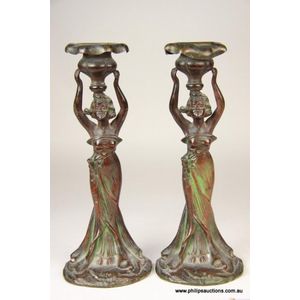Art Nouveau Clock Garniture Set
You must be a subscriber, and be logged in to view price and dealer details.
Subscribe Now to view actual auction price for this item
When you subscribe, you have the option of setting the currency in which to display prices to $Au, $US, $NZ or Stg.
- Movement - The technical name for the workings of a clock or watch, and does not include the dial or case.
- Art Nouveau Period - The Art Nouveau period was a cultural movement that emerged in the late 19th century, and was characterized by its emphasis on natural forms, flowing lines, and a decorative, ornamental style. Art Nouveau was a reaction against the ornate and heavily stylized designs of the previous era, and sought to create a new, more organic aesthetic.
Art Nouveau was characterized by its use of sinuous, curving lines, as well as a focus on natural elements such as flowers, vines, and other organic shapes. Art Nouveau designers sought to create a total work of art, in which every element of a building or object was designed to be harmonious with the overall design.
Some of the most iconic examples of Art Nouveau design include the Paris Metro entrances designed by Hector Guimard, the works of the artist Alphonse Mucha, and the architecture of Victor Horta in Brussels.
The Art Nouveau period was at its peak between 1890 and 1910, but began to decline in popularity by the start of World War I. However, Art Nouveau remains an important influence on design and art to this day, and continues to be celebrated for its emphasis on natural forms and decorative style. - Spelter - Spelter was the name given to an alloy of zinc and brass or copper used in the 19th century for statuary and lighting. It is a brittle bluish-white metal. It was used as a cheap replacement for bronze, but being brittle easily breaks and can't be repaired. When finished it can often be mistaken for bronze, but if discreet a scratch on the base displays shows a greyish colour, the metal is spelter, if a golden colour the metal is most likely bronze.
This item has been included into following indexes:
- clocks, type
Visually similar items

A rare pair of Mintons tete d'elephant gilt metal mounted porcelain vases, circa 1878 each with twin rose shaped candle branches, figurative and floral cartouches to cobalt blue and gilt vermicule reserves. Impressed Mintons, year cypher and further potter

A pair of spelter Art Nouveau style candlesticks, the cast sticks in the form of a sinuous woman holding a lotus style urn above her head; with green coloration. Height 23 cm

Art Deco French mantle clock and garnitures, clock approx 28 cm high, 49 cm wide, 20 cm deep (3)

LucieSignoret-Ledieu (1858-1904), gilded bronze sculpture 'Nymphe De Diane', she sits on a rocky mound with bow to her left hand and quiver below, her right arm raised holding a single flower, raised to the base with a single fish, signed, the circular wai
